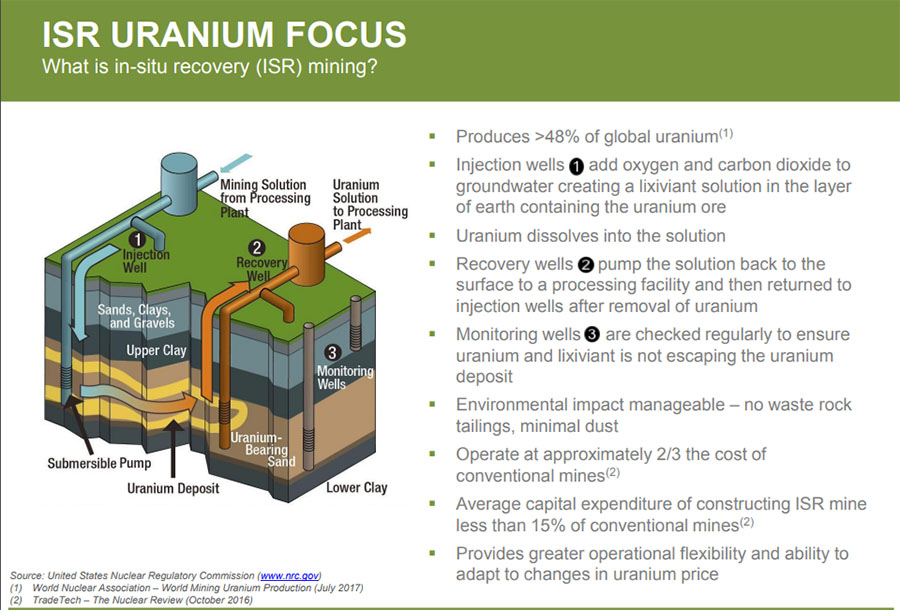Source: Streetwise Reports 07/26/2018
The U.S. Department of Commerce investigation into whether uranium imports threaten national security could lead to the imposition of tariffs that would benefit firms with American mines such as Azarga Uranium. Streetwise Reports spoke with Azarga’s chairman Glenn Catchpole and CEO Blake Steele about the state of the uranium market and the company’s recent merger with URZ Energy.
The Energy Report: In response to a Section 232 petition by Energy Fuels Inc. (EFR:TSX; UUUU:NYSE.American) and Ur-Energy Inc. (URG:NYSE.MKT; URE:TSX), the U.S. Commerce Department declared that it has opened an investigation into whether uranium imports threaten U.S. national security. How does this change the market landscape for uranium?
Blake Steele: This is potentially a very exciting catalyst for the U.S. uranium industry. President Trump has been protective of other U.S. industries, imposing steel and aluminum tariffs on the back of a Section 232 petition as well. And currently, the U.S. produces less than 5% of its annual uranium consumption while nuclear energy accounts for approximately 20% of the electrical grid.
Ultimately, this investigation has the potential to create a uranium market with two prices. One, there’s going to be a global price for production destined for non-U.S. consumption. And two, there’s going to be a price for U.S. domestic production, which will likely be meaningfully higher. Azarga Uranium Corp.’s (AZZ:TSX) asset suite is well positioned to take advantage of this.
In terms of timing, the Secretary of Commerce has 270 days to report and propose recommendations to President Trump. Trump then has 90 days to take action on those recommendations, should any actions be necessary to address the threat.
TER: Aside from this investigation, what other things are happening on a macroeconomic level with uranium? Prices have been low for a long time.
BS: You’re right, prices have been depressed for a prolonged period of time. Globally, we’re finally starting to see producers slashing supply. Producers have eliminated or are in the process of eliminating more than 30 million pounds (30 Mlb) of annual production since 2016. In conjunction, utilities have been underbuying in recent years, running down stockpiles and contract positions put in place pre-Fukushima, when European and U.S. utilities were concerned about market tightness due to rapid growth out of China.
You couple this with large funds being established to hold physical uranium, the U.S. Department of Energy halting sales to fund clean-up programs and Cameco Corp. (CCO:TSX; CCJ:NYSE) buying large volumes in the spot price while Japan continues to restart reactors, it’s a bit of a perfect storm here. All of these events are putting pressure on prices as spot supply begins to dry up.
In conjunction again with this, demand is growing. China is forecast to construct six to eight nuclear reactors per year, increasing to 10 after 2020. Japan will require approximately 30 reactors being back online to achieve its goal of powering 20–22% of its grid through nuclear.
One of the most significant upcoming catalysts could be McArthur River going into care and maintenance beyond the previously announced 10-month suspension. I would expect to see an announcement on this before the end of this quarter. (Editor’s note: On July 25, Cameco announced the suspension of McArthur River for an indeterminate duration.)
So all of these factors considered, I think it’s presenting a very interesting dynamic for the next 12 months in the uranium sector, the start of potentially a bull market here.
TER: One thing that I’m curious about is that most of the utilities that require uranium buy it on long-term contracts, and those contracts in the past have been in the $50 per pound ($50/lb) range. The spot price is well below that. As those contracts expire are the utility operators buying on the spot market? Are they going for new long-term contracts at lower rates?
BS: Contracting to date has been generally slow. Utilities over the last few years have been picking up pounds on the spot market, but this fundamentally has to change. As a result of those factors previously mentioned, the supply in the spot market is really drying up. Now, couple that with the fact that in excess of 75% of producers are not making money at current spot prices, they’re not going to be entering into contracts with utilities at anywhere near this price point. So I think when the utilities start contracting in a meaningful way, we are going to see long-term prices substantially north of where they and the spot price are today.
TER: Let’s turn now to your merger. Azarga completed the merger with URZ Energy Corp. on July 5. Would you talk a little bit about the merger and the benefits of the amalgamation?
BS: From our perspective, the merger presented an opportunity to create the only pure-play in situ recovery (ISR)-focused uranium developer in the U.S. The merged company has in excess of 30 Mlb of Measured and Indicated resources and 8.7 Mlb of Inferred resources located in the U.S. So we’re talking about scale focused in the U.S., which, with this 232 petition, seems to be the place you want to be right now.
The company’s flagship asset, the Dewey Burdock project in South Dakota, is the highest-grade undeveloped ISR project in the U.S. And adding URZ’s pipeline of assets, which includes the Gas Hills project in Wyoming, was a natural fit.
The merger also created a vehicle with an enhanced market position and a more diversified shareholder base, broadening investor and analyst appeal. Creating additional liquidity and investor interest in the uranium sector I think is an important goal for any vehicle.
TER: How have you consolidated the management teams?
BS: The combined management team is very interesting. We have over 100 years of experience in the ISR space, including development, design, permitting and operational experience. We have a very strong board with a diverse skill set, led by Glenn …read more
From:: The Energy Report

